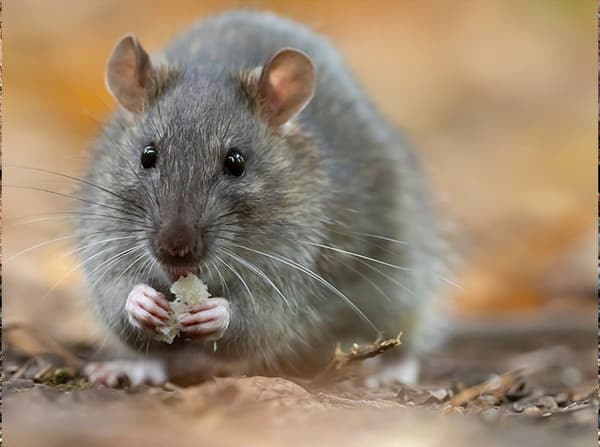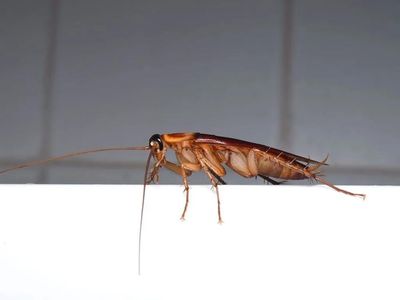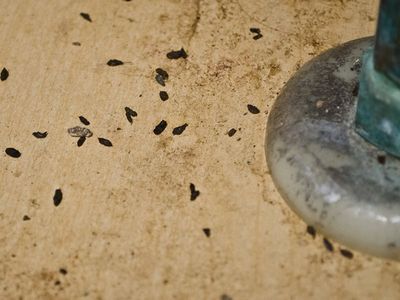What do Norway rats look like?
Norway rats are typically brown. They measure 7 to 10 inches in length and have a thick tail that is 6 to 8 inches long. Norway rats are stocky rodents with a blunt snout, pink nose, small ears, black eyes, pale feet, and sharp claws.

Do Norway rats bite?
Yes, Norway rats bite, but in most cases, they will not bite unless they are provoked. Though, not prone to bite, it is best to not go into confined spaces where these rodents are present.
Are Norway rats dangerous?
Yes, they are considered dangerous in many ways. It is essential to understand the dangers so that you can mitigate the risks.
- The fecal matter left by Norway rats is a disease concern and may contain Hantavirus.
- Hairs deposited by Norway rats are often a disease concern because these animals pass through sewer systems and climb in trash bins.
- Norway rats pick up ticks, fleas, and other ectoparasites that are linked to human disease transmission.
You should not allow these animals to live in your home or business.
What are Norway rats attracted to?
Norway rats are primarily motivated by water, food, and harborage. Here are the ways they approach these attractants.
- Norway rats (commonly called sewer rats or wharf rats) have a strong attraction to damp environments and properties with available water sources.
- Norway rats eat a wide range of natural foods, including nuts, seeds, fruits, and bugs. They're drawn to properties that provide these resources.
- Norway rats are not picky eaters. They'll feed on decaying organic matter in your garbage. If you have uncovered trash or dirty trash receptacles, these things can attract the attention of Norway rats.
- Some urban Norway rats turn to dog droppings as a food source. It is not a preference, but it is certainly a factor that can attract unwanted rodent activity.
- Thick vegetation, unprotected deck voids, a crawl space under your home, stacked logs, and junk piles can attract Norway rats.
- Norway rats tunnel in the ground. Soft soil is an attractant.
How do these rats get inside?
Norway rats tend to stay near the ground. When they enter a structure, it is typically through a gap or crack that is low to the ground. Here are a few quick examples:
- Openings around pipes or wire conduits
- Gaps in garage or exterior door sweeps
- Gaps in weatherstripping
- Damaged screens
- Rotted window or door frames
- Unprotected vents
In most cases, Norway rats will stay close to the ground. But they are adaptable animals. If given proper incentive, they may climb trees and get into your home through high entry points.
Where do Norway rats nest?
As we pointed out, Norway rats are ground rats. They prefer to nest in ground tunnels. But they don't stay in the ground, the way moles do. They go out to collect food and drink water and then return to their ground nests.
When a Norway rat comes into your yard, it wants to establish a ground nest under cover. In your yard, they'll nest in the ground underneath a pile of junk, a pallet of stored items, a shed, etc.
If your home has a crawl space, it is uniquely vulnerable to Norway rats. These rodents love to get into the dirty underbelly of a home. In this space, they nest in the ground and enter the home through the holes they chew in wooden supports. Once inside, they can nest in wall voids.
How do I get rid of Norway rats?
If you’ve found evidence that Norway rats or other rodents are infesting your home or business, contact Evergreen Pest Solutions for help. We offer residential and commercial pest control services that stop these destructive pests from taking over!
How can I prevent a Norway rat problem?
You may deter these rodents by applying countermeasures to address the conditions that attract them and promote nesting. Here are some suggestions:
- Remove containers that capture rainwater.
- Clear out gutter clogs to prevent puddles next to your home.
- Remove bird feeders.
- Rake up nuts.
- Remove piles of junk.
- Keep your trash receptacles covered and clean.
- Use fencing material to keep Norway rats out from underneath your deck.
- Make sure your crawl space is protected.
- Use a caulking gun and expanding foam to fill in potential entry points.
- Replace damaged weatherproofing materials.
- Protect vents.
Remember that you're never alone when it comes to keeping rats out of your home. Contact your Evergreen Pest Solutions team for rodent population control around your home. Our licensed technicians use industry-leading control solutions to keep these harmful pests out. Connect with us today to schedule a service visit.








